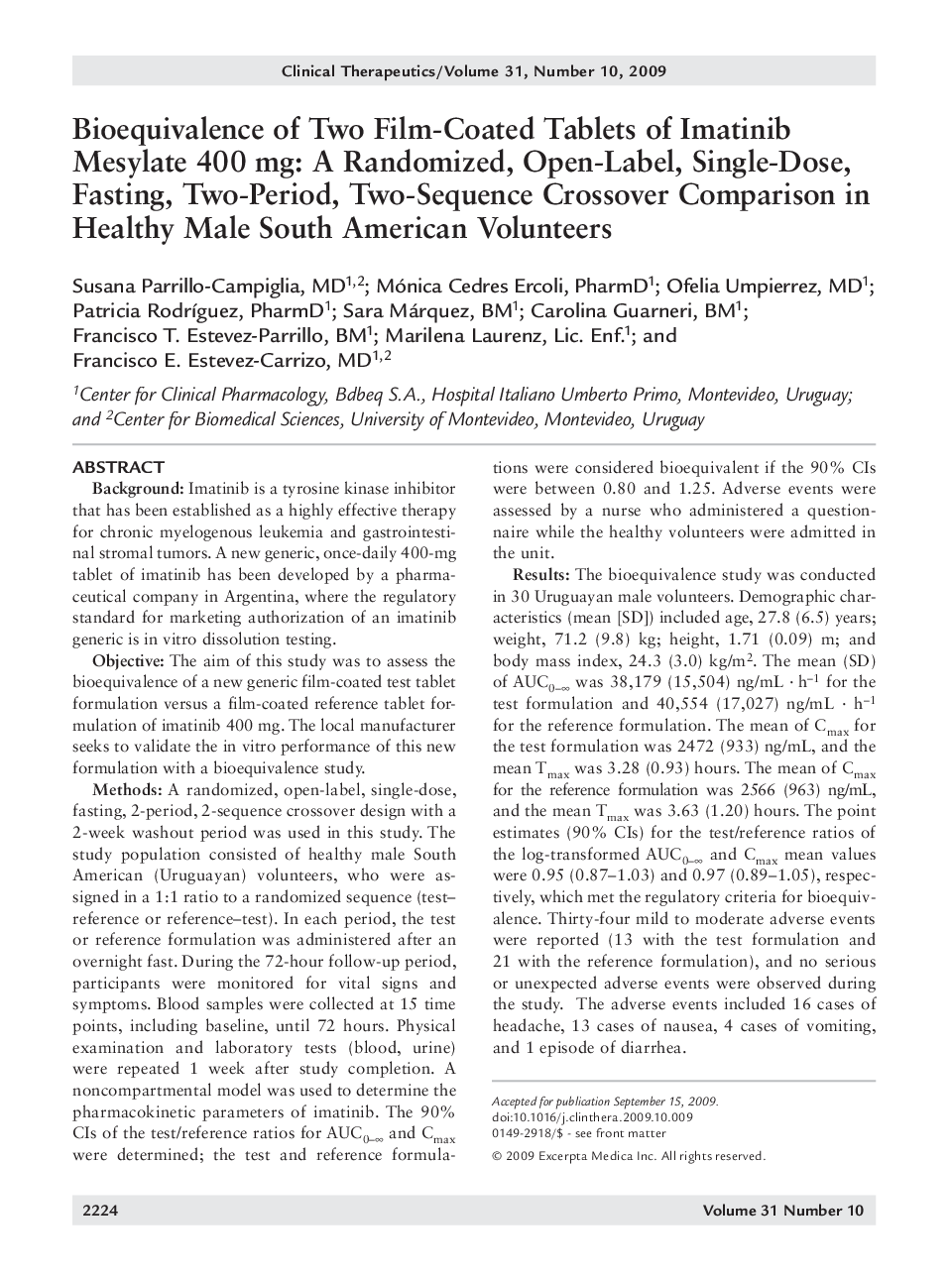| کد مقاله | کد نشریه | سال انتشار | مقاله انگلیسی | نسخه تمام متن |
|---|---|---|---|---|
| 2528304 | 1119963 | 2009 | 9 صفحه PDF | دانلود رایگان |

Background: Imatinib is a tyrosine kinase inhibitor that has been established as a highly effective therapy for chronic myelogenous leukemia and gastrointestinal stromal tumors. A new generic, once-daily 400-mg tablet of imatinib has been developed by a pharmaceutical company in Argentina, where the regulatory standard for marketing authorization of an imatinib generic is in vitro dissolution testing.Objective: The aim of this study was to assess the bioequivalence of a new generic film-coated test tablet formulation versus a film-coated reference tablet formulation of imatinib 400 mg. The local manufacturer seeks to validate the in vitro performance of this new formulation with a bioequivalence study.Methods: A randomized, open-label, single-dose, fasting, 2-period, 2-sequence crossover design with a 2-week washout period was used in this study. The study population consisted of healthy male South American (Uruguayan) volunteers, who were assigned in a 1:1 ratio to a randomized sequence (test-reference or reference-test). In each period, the test or reference formulation was administered after an overnight fast. During the 72-hour follow-up period, participants were monitored for vital signs and symptoms. Blood samples were collected at 15 time points, including baseline, until 72 hours. Physical examination and laboratory tests (blood, urine) were repeated 1 week after study completion. A noncompartmental model was used to determine the pharmacokinetic parameters of imatinib. The 90% CIs of the test/reference ratios for AUC0-∞ and Cmax were determined; the test and reference formulations were considered bioequivalent if the 90% CIs were between 0.80 and 1.25. Adverse events were assessed by a nurse who administered a questionnaire while the healthy volunteers were admitted in the unit.Results: The bioequivalence study was conducted in 30 Uruguayan male volunteers. Demographic characteristics (mean [SD]) included age, 27.8 (6.5) years; weight, 71.2 (9.8) kg; height, 1.71 (0.09) m; and body mass index, 24.3 (3.0) kg/m2. The mean (SD) of AUC0-∞ was 38,179 (15,504) ng/mL · h−1 for the test formulation and 40,554 (17,027) ng/mL · h−1 for the reference formulation. The mean of Cmax for the test formulation was 2472 (933) ng/mL, and the mean Tmax was 3.28 (0.93) hours. The mean of Cmax for the reference formulation was 2566 (963) ng/mL, and the mean Tmax was 3.63 (1.20) hours. The point estimates (90% CIs) for the test/reference ratios of the log-transformed AUC- and Cmax mean values were 0.95 (0.87–1.03) and 0.97 (0.89–1.05), respectively, which met the regulatory criteria for bioequiv-alence. Thirty-four mild to moderate adverse events were reported (13 with the test formulation and 21 with the reference formulation), and no serious or unexpected adverse events were observed during the study. The adverse events included 16 cases of headache, 13 cases of nausea, 4 cases of vomiting, and 1 episode of diarrhea.Conclusions: The results of this study suggest that the test formulation of imatinib met the regulatory criteria for bioequivalence to the reference formulation in these healthy fasting male volunteers. Both formulations were generally well tolerated and appeared to have a similar adverse-event profile.
Journal: Clinical Therapeutics - Volume 31, Issue 10, October 2009, Pages 2224-2232